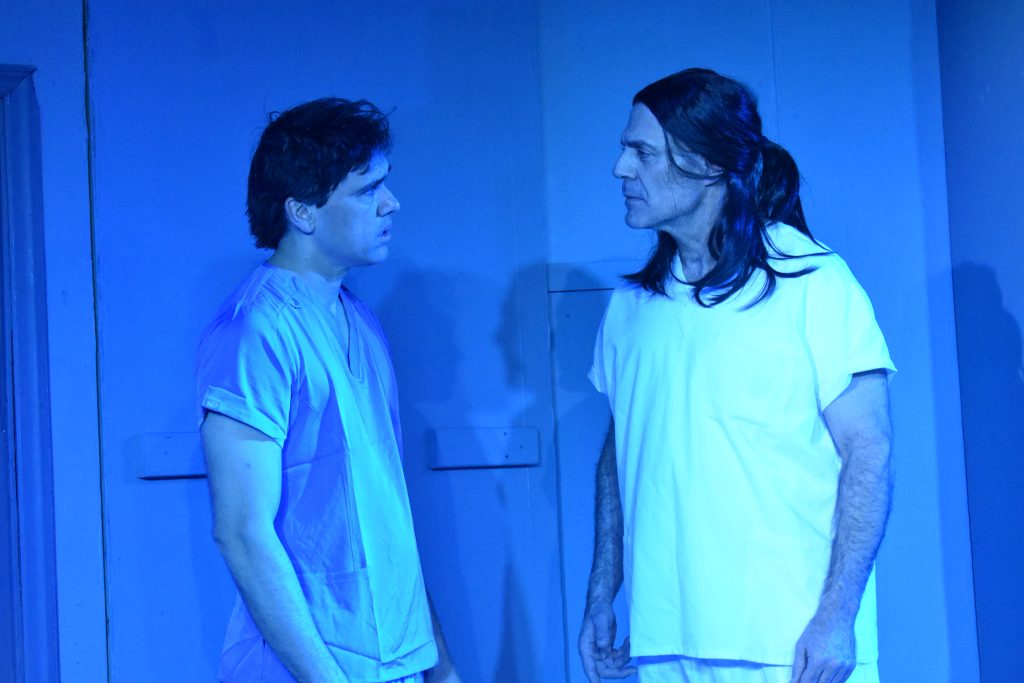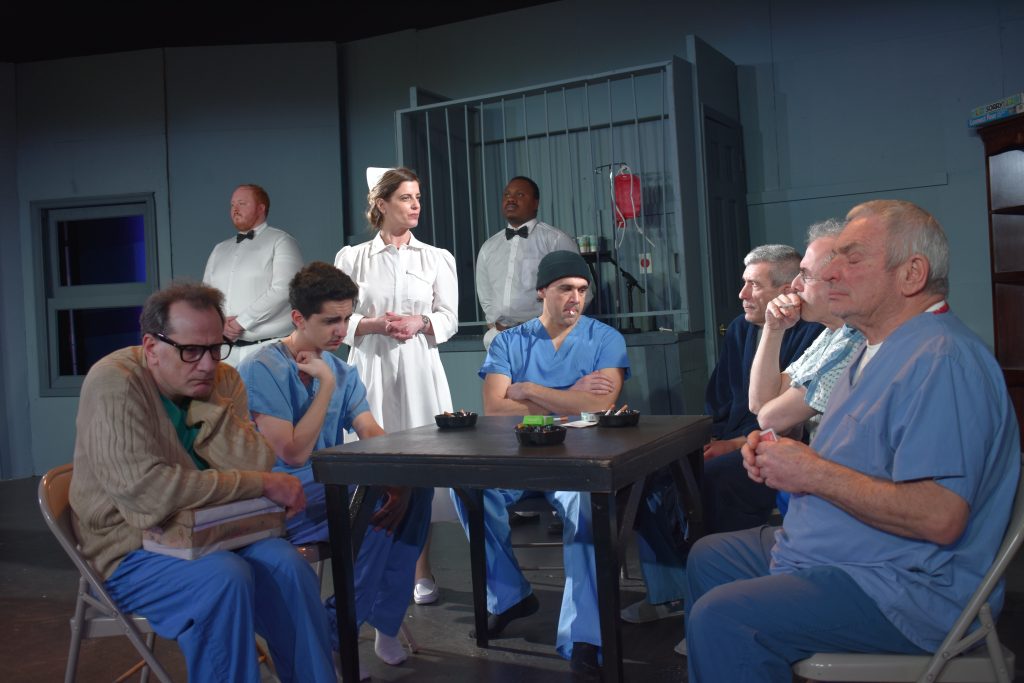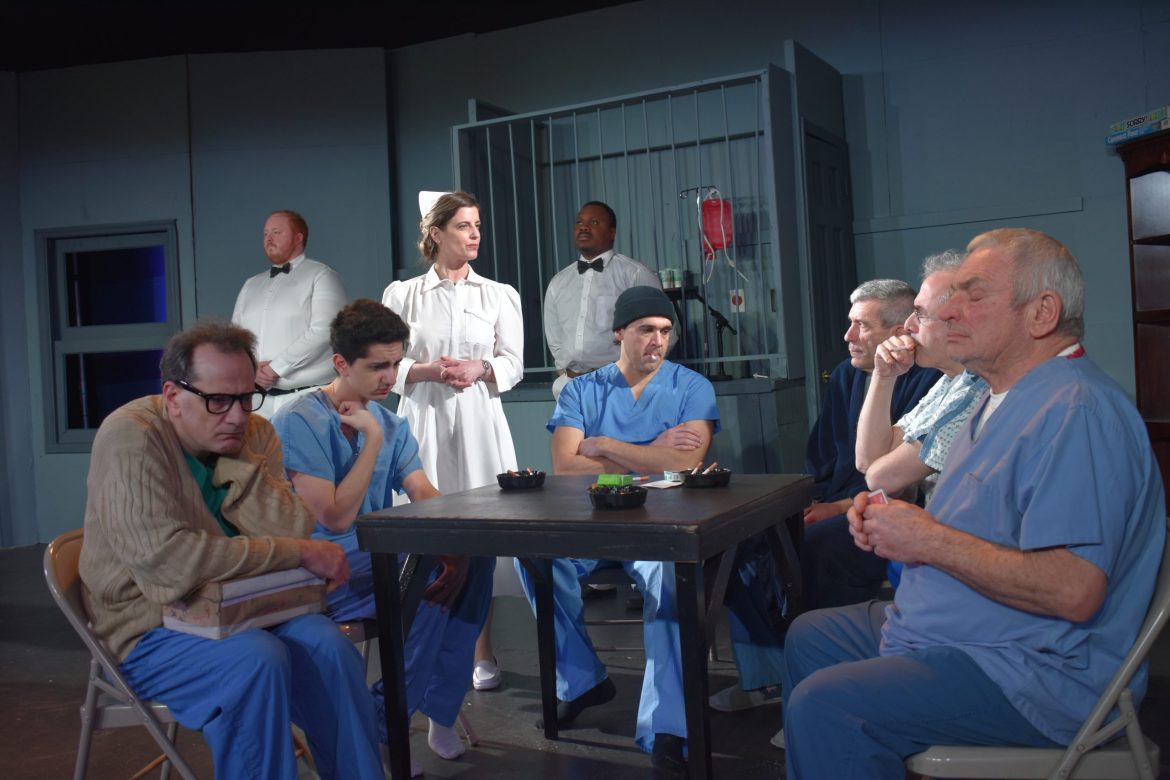

Photo Credit: Brianna Acevedo-Franchino
Three geese in a flock
One flew East
One flew West
And one flew over the cuckoo’s nest
This innocent part of a nursery rhyme becomes a desperate cry to escape in One Flew Over the Cuckoo’s Nest.
In 1959, author, Ken Kesey, armed with all he had witnessed while working as an orderly at a mental health facility in California, authored this groundbreaking novel which was published in 1962, at a time when changes were on the horizon to correct the harsh treatment of patients in mental institutions. Prior to that time, such drastic methods such as electric shocks, frontal lobotomies and strong mind-altering drugs were commonplace practices. With these changes also came deinstitutionalizing psychiatric wards like the one described by Kesey. A strong message in Cuckoo’s Nest is a call to place a magnifying glass over psychiatric institutions and expose their methods of oppression.
The book was adapted for the stage by playwright, Dale Wasserman, and opened on Broadway, November 13, 1963, running through January 25, 1964. In 2001, the play returned to Broadway winning the Tony Award for Best Play Revival.
In 1975, the film version directed by Milos Forman starred Jack Nicholson as the rebellious Randle P. McMurphy, the criminal who bucks the system stirring up the ward and becoming a perfect foil to Nurse Ratched’s authoritarian rule. It has been recognized as No. 33 on the American Film Institute’s 100 Years…100 Movies list and in 1976 won five Academy Awards for Best Picture, Best Actor (Jack Nicholson), Best Actress (Louise Fletcher), Director (Milos Forman) and Screenplay (Lawrence Hauben/Bo Goldman).
The Manes Studio Theatre’s production of One Flew Over the Cuckoo’s Nest under the outstanding direction of Mike Blangiforti reverberates in the mind long after the lights go up. The play unfolds in the day room of the mental asylum. Set Designer, Michael Visco, has created an appropriately sterile environment with a backdrop of dull, gray walls and ominous nurse’s station, up center, composed of prison-like railings deliberately cutting it off from the rest of the ward and providing a safe haven for nurses to escape the antics on the floor. Much of the action takes place around a simple card table surrounded by metal folding chairs, a sofa and Chief Bromden’s rocking chair.
The patients are categorized as the Acutes ( deemed as curable and are there voluntarily) and Chronics (incurable and will never leave). The Acutes are Dale Harding, Billy Bibbit, Cheswick, Scanlon, Martini, while Ruckley and Chief Bromden are the Chronics.
Solomon Buchman is compelling as Chief Bromden, a tall, imposing Native American patient who presents himself as deaf and mute while suffering from paranoia and hallucinations. He is the narrator, stepping out of the action and into a spotlight where he sits in a rocker delivering monologues to his deceased father about the oppressive societal conditions that he calls The Combine. Michael Visco’s lighting design establishes these eerie asides that are laced throughout the play. In Act II, Visco’s use of strobe effects for the electric shocks is chilling.
Joseph Cavagnet’s Dale Harding is multi-dimensional as the articulate, unofficial leader of the patients. He appears so intelligent and in control that one wonders why he is there until the truth is exposed in a pivotal scene that sets him reeling. Logan Calabrese makes the boyish, easily intimidated stutterer, Billy Bibbit, come to life replete with twitchy movements that accentuate his every word. Billy fears women in authority especially his mother and Nurse Ratched. He is a virgin, a condition McMurphy intends to rid him of.
Mary Caulfield is frightening as the insidious Nurse Ratched with ice running through her veins. There is a menacing staccato to her gait matching her measured words and sardonic smile. She relishes her authority over this group of spineless men, especially Billy whom she harasses regularly with threats of calling his mother regarding his actions in the ward. Her thirst to victimize is only quenched when she insights hysterics among the patients.
Randle P. McMurphy (Diego Andres) storms into the day room and with him comes a strong dose of excitement in this otherwise submissive ward. He is a con man who was charged with battery, gambling and rape though that charge was never proven. Originally sentenced to serve a six month term at a work farm, he convinces authorities that he is a psychopath and is transferred to the mental hospital which he prefers as a way to get out of work. He is immediately at odds with the tyrannical Nurse Ratched undermining her authority until he is hit with the revelation that he is on the committed list, which means his time in the ward is subject to her whim. The program notes McMurphy is the first major role in Andres’ career which seems incomprehensible as he gives a tour de force performance.
This fiercely strong ensemble is rounded out with the mesmerizing performances of Acute patients Cheswick (Ethan Fried), Scanlon (Scott Earle), Martini (Joe DiPietro) and the Chronic patient Ruckley (Matt Harding-Flanagan), who has mastered the vegetative state. Nurse Flinn played by Barbara McGivney is perfectly mousy and skittish. Angelo DiBiase’s Dr Spivey makes us believe he is weary from constant coercion at the hands of Nurse Ratched. Aides Williams (Rohan Lawrence) and Warren (Zach Rudd) are the frightful henchmen of Nurse Ratched sending shivers as they carry out her bidding. The night Aide Turkle (Frank Tangredi) is deliciously devious allowing Candy Starr to visit McMurphy in the ward in exchange for a bottle of liquor. Mahi Singh plays McMurphy’s girlfriend, Candy Starr, to the hilt, enjoying her sexuality as she seduces innocent Billy Bibbit. Janely Montgomery plays Sandra, Candy’s friend, who joins in the fun with gusto.
Chrissy Van Syckle’s costumes add definition to the characters. In his first entrance, McMurphy projects a tough guy image with black skull cap and leather jacket. By contrast, Nurse Ratched’s stiffly starched white uniform is a metaphor for her unyielding nature. The patients seem to lose their individuality as they all wear hospital blue trousers. Candy Starr’s sexy persona is accentuated by tight red camisole and black flair mini skirt.
One Flew Over the Cuckoo’s Nest has soared into Studio Theatre bringing with it a haunting, exciting and thought provoking production that will leave you entranced long after the final scene.
Playing now through February 25 at Manes Studio Theatre Of Long Island.
141 S. Wellwood Avenue, Lindenhurst, NY 11757. (631) 226-8400
www.STUDIOTHEATRELONGISLAND.COM

